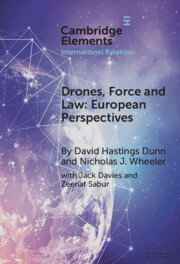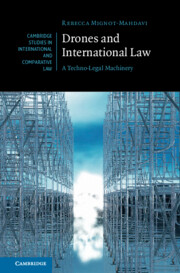Refine search
Actions for selected content:
67 results
Red-footed booby population thriving at globally significant Aldabra Atoll: insights from unmanned aerial vehicle surveys
-
- Journal:
- Oryx , First View
- Published online by Cambridge University Press:
- 13 November 2025, pp. 1-11
-
- Article
-
- You have access
- Open access
- HTML
- Export citation
The Challenges of Designing a Rescue Pack Carrying Blood Transfusion Bags in Disasters and Emergencies by Rescue Drones
-
- Journal:
- Disaster Medicine and Public Health Preparedness / Volume 19 / 2025
- Published online by Cambridge University Press:
- 04 September 2025, e255
-
- Article
- Export citation
The drone revolution: Towards a synthesis in the drone debate
-
- Journal:
- European Journal of International Security , First View
- Published online by Cambridge University Press:
- 16 July 2025, pp. 1-21
-
- Article
-
- You have access
- Open access
- HTML
- Export citation
Site-Specific Treatment of Late-Season Weed Escapes in Rice Utilizing a Remotely Piloted Aerial Application System
-
- Journal:
- Weed Technology / Volume 39 / 2025
- Published online by Cambridge University Press:
- 04 July 2025, e74
-
- Article
-
- You have access
- Open access
- HTML
- Export citation
Chaplains and the legitimacy of drone warfare: experimental evidence from the US Army
-
- Journal:
- Politics and Religion / Volume 18 / Issue 3 / September 2025
- Published online by Cambridge University Press:
- 25 June 2025, pp. 351-382
-
- Article
-
- You have access
- Open access
- HTML
- Export citation
3 - The Existential Unsettling of Security
- from Part II - Confronting Global Contradictions
-
- Book:
- Global Crisis and Insecurity
- Published online:
- 01 June 2025
- Print publication:
- 12 June 2025, pp 61-85
-
- Chapter
- Export citation
6 - Internationalized Intrastate Conflict
-
- Book:
- Civil War and Intrastate Armed Conflict
- Published online:
- 29 May 2025
- Print publication:
- 12 June 2025, pp 186-228
-
- Chapter
- Export citation
Artificial intelligence in low-altitude flight: Developmental opportunity or ethical challenge?
-
- Journal:
- The Aeronautical Journal / Volume 129 / Issue 1336 / June 2025
- Published online by Cambridge University Press:
- 03 March 2025, pp. 1683-1701
-
- Article
- Export citation
Environmental correlates of breeding outcomes in Endangered Grey Crowned Cranes Balearica regulorum in agricultural areas of KwaZulu-Natal, South Africa
- Part of
-
- Journal:
- Bird Conservation International / Volume 35 / 2025
- Published online by Cambridge University Press:
- 16 January 2025, e2
-
- Article
-
- You have access
- Open access
- HTML
- Export citation
Returning the War to Russia: Drones and Discrimination in the Defense of Ukraine
-
- Journal:
- Ethics & International Affairs / Volume 38 / Issue 1 / Spring 2024
- Published online by Cambridge University Press:
- 01 October 2024, pp. 54-63
-
- Article
-
- You have access
- Open access
- HTML
- Export citation
Low-cost tree crown dieback estimation using deep learning-based segmentation
-
- Journal:
- Environmental Data Science / Volume 3 / 2024
- Published online by Cambridge University Press:
- 18 September 2024, e18
-
- Article
-
- You have access
- Open access
- HTML
- Export citation

Drones, Force and Law
- European Perspectives
-
- Published online:
- 04 December 2023
- Print publication:
- 18 January 2024
-
- Element
- Export citation
Above the law: Drones, aerial vision and the law of armed conflict – a socio-technical approach
-
- Journal:
- International Review of the Red Cross / Volume 105 / Issue 924 / December 2023
- Published online by Cambridge University Press:
- 15 November 2023, pp. 1690-1728
- Print publication:
- December 2023
-
- Article
-
- You have access
- Open access
- HTML
- Export citation
12 - Drone Warfare
- from Part V - Special Topics in Conflict
-
-
- Book:
- Understanding War and Peace
- Published online:
- 06 July 2023
- Print publication:
- 20 July 2023, pp 371-404
-
- Chapter
- Export citation
7 - Rituals of Sovereignty
-
- Book:
- Drones and International Law
- Published online:
- 31 May 2023
- Print publication:
- 13 July 2023, pp 182-210
-
- Chapter
- Export citation
1 - Drone Programs Reconfiguring War, Law, and Societies around Threat Anticipation
-
- Book:
- Drones and International Law
- Published online:
- 31 May 2023
- Print publication:
- 13 July 2023, pp 1-16
-
- Chapter
- Export citation
4 - Targeting Hostile Individuals
-
- Book:
- Drones and International Law
- Published online:
- 31 May 2023
- Print publication:
- 13 July 2023, pp 87-118
-
- Chapter
- Export citation
2 - Contexts
-
- Book:
- Drones and International Law
- Published online:
- 31 May 2023
- Print publication:
- 13 July 2023, pp 17-40
-
- Chapter
- Export citation

Drones and International Law
- A Techno-Legal Machinery
-
- Published online:
- 31 May 2023
- Print publication:
- 13 July 2023
Assessing the potential disturbance effects on the use of Unmanned Aircraft Systems (UASs) for European vultures research: a review and conservation recommendations
-
- Journal:
- Bird Conservation International / Volume 33 / 2023
- Published online by Cambridge University Press:
- 02 February 2023, e45
-
- Article
-
- You have access
- Open access
- HTML
- Export citation
